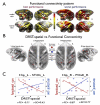Hippocampal network connections account for differences in memory performance in the middle-aged rhesus monkey
- PMID: 23780752
- PMCID: PMC4113965
- DOI: 10.1002/hipo.22156
Hippocampal network connections account for differences in memory performance in the middle-aged rhesus monkey
Abstract
Recent neurophysiological and functional neuroimaging studies suggest that the memory decline found with normal aging is not solely due to regional disruptions in the hippocampus, but also is brought about by alterations in the functional coupling between the hippocampus and long-distance neocortical regions. However, the anatomical basis for this functional "dyscoupling" has not been fully revealed. In this study, we applied a multimodal magnetic resonance imaging technique to noninvasively examine the large-scale anatomical and functional hippocampal network of a group of middle aged rhesus monkeys. Using diffusion spectrum imaging, we have found that monkeys with lower memory performance had weaker structural white matter connections between the hippocampus and neocortical association areas. Resting state functional imaging revealed somewhat of an opposite result. Monkeys with low memory performance displayed elevated coupling strengths in the network between the hippocampus and the neocortical areas. Taken together with recent findings, this contradictory pattern may be the result of either underlying physiological burden or abnormal neuronal decoupling due to the structural alterations, which induce a neuronal compensation mechanism for the structural loss or interference on task related neuronal activation, respectively.
Keywords: TEA; chemical LTD; chemical LTP; glycine; spine remodeling.
Copyright © 2013 Wiley Periodicals, Inc.
Figures





Similar articles
-
Structural and functional correlates of behavioral pattern separation in the hippocampus and medial temporal lobe.Hippocampus. 2015 Apr;25(4):524-33. doi: 10.1002/hipo.22389. Epub 2014 Nov 27. Hippocampus. 2015. PMID: 25394655
-
Hippocampal-neocortical networks differ during encoding and retrieval of relational memory: functional and effective connectivity analyses.Neuropsychologia. 2010 Sep;48(11):3272-81. doi: 10.1016/j.neuropsychologia.2010.07.010. Epub 2010 Jul 15. Neuropsychologia. 2010. PMID: 20637787
-
Functionally linked resting-state networks reflect the underlying structural connectivity architecture of the human brain.Hum Brain Mapp. 2009 Oct;30(10):3127-41. doi: 10.1002/hbm.20737. Hum Brain Mapp. 2009. PMID: 19235882 Free PMC article.
-
Evolution of declarative memory.Hippocampus. 2006;16(9):795-808. doi: 10.1002/hipo.20205. Hippocampus. 2006. PMID: 16881079 Review.
-
[The hippocampus and the neural code of spatial memory].Biol Aujourdhui. 2010;204(2):103-12. doi: 10.1051/jbio/2010009. Epub 2010 Jun 21. Biol Aujourdhui. 2010. PMID: 20950555 Review. French.
Cited by
-
Long-term effects of curcumin in the non-human primate brain.Brain Res Bull. 2018 Sep;142:88-95. doi: 10.1016/j.brainresbull.2018.06.015. Epub 2018 Jul 4. Brain Res Bull. 2018. PMID: 29981358 Free PMC article.
-
Corticosterone potentiates DFP-induced neuroinflammation and affects high-order diffusion imaging in a rat model of Gulf War Illness.Brain Behav Immun. 2018 Jan;67:42-46. doi: 10.1016/j.bbi.2017.08.003. Epub 2017 Aug 4. Brain Behav Immun. 2018. PMID: 28782715 Free PMC article.
-
Enhanced long-term potentiation in the anterior cingulate cortex of tree shrew.Philos Trans R Soc Lond B Biol Sci. 2024 Jul 29;379(1906):20230240. doi: 10.1098/rstb.2023.0240. Epub 2024 Jun 10. Philos Trans R Soc Lond B Biol Sci. 2024. PMID: 38853555 Free PMC article.
-
Why primate models matter.Am J Primatol. 2014 Sep;76(9):801-27. doi: 10.1002/ajp.22281. Epub 2014 Apr 10. Am J Primatol. 2014. PMID: 24723482 Free PMC article. Review.
-
Preclinical Magnetic Resonance Imaging and Spectroscopy Studies of Memory, Aging, and Cognitive Decline.Front Aging Neurosci. 2016 Jun 29;8:158. doi: 10.3389/fnagi.2016.00158. eCollection 2016. Front Aging Neurosci. 2016. PMID: 27468264 Free PMC article. Review.
References
-
- Anderson MJ, Robinson J. Permutation tests for linear models. Aust N Z J Stat. 2001;43:75–88.
-
- Barbas H, Blatt GJ. Topographically specific hippocampal projections target functionally distinct prefrontal areas in the rhesus monkey. Hippocampus. 1995;5:511–533. - PubMed
-
- Beason-Held LL, Rosene DL, Killiany RJ, Moss MB. Hippocampal formation lesions produce memory impairment in the rhesus monkey. Hippocampus. 1999;9:562–574. - PubMed
-
- Biswal B, Yetkin FZ, Haughton VM, Hyde JS. Functional connectivity in the motor cortex of resting human brain using echo-planar MRI. Magn Reson Med. 1995;34:537–541. - PubMed
Publication types
MeSH terms
Substances
Grants and funding
LinkOut - more resources
Full Text Sources
Other Literature Sources
Medical

